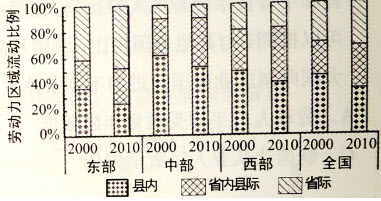问题
单项选择题
(八)在经济开放的条件下,劳动力倾向于从经济落后地区向发达地区流动,通过地区间观念、信息和技术的交流,促使地区间的经济差异逐渐缩小,劳动力流动减弱。
图中数据显示,从2000年到2010年十年间,我国东部地区经济发展的特点是()。

①省际经济差异变小
②县内经济差异变小
③省际经济差异变大
④县内经济差异变大
A.①②
B.②③
C.③④
D.①④
答案
参考答案:B
(八)在经济开放的条件下,劳动力倾向于从经济落后地区向发达地区流动,通过地区间观念、信息和技术的交流,促使地区间的经济差异逐渐缩小,劳动力流动减弱。
图中数据显示,从2000年到2010年十年间,我国东部地区经济发展的特点是()。

①省际经济差异变小
②县内经济差异变小
③省际经济差异变大
④县内经济差异变大
A.①②
B.②③
C.③④
D.①④
参考答案:B